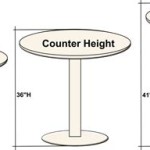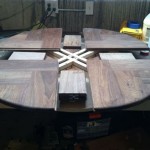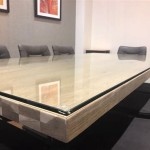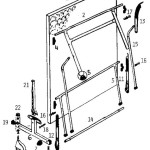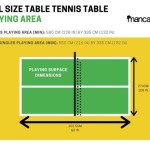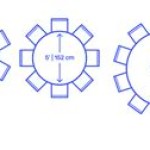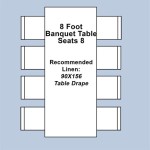The Enduring Appeal of the Tree Trunk End Table
The tree trunk end table represents a fascinating intersection of rustic charm and modern design. This unique piece of furniture brings a touch of the outdoors inside, offering a raw, organic aesthetic that complements a variety of interior styles. More than just a functional surface, a tree trunk end table serves as a statement piece, a conversation starter, and a tangible connection to the natural world. Its appeal lies not only in its visual beauty but also in its inherent durability and the story it tells of the tree from which it originated.
The construction of a tree trunk end table typically involves sourcing a suitable tree trunk, drying and treating the wood to prevent cracking and decay, and then shaping and finishing the surface to create a usable table. The process can range from minimalist approaches, which preserve the natural form of the trunk, to more elaborate designs that incorporate metal or glass elements. The choice of wood species plays a significant role in the table's appearance and durability, with popular options including oak, walnut, cedar, and redwood.
The versatility of the tree trunk end table allows it to function in various settings, from living rooms and bedrooms to patios and gardens. Its solid construction makes it a reliable surface for lamps, books, drinks, and other items. Furthermore, its inherent weight provides stability, preventing it from easily tipping over. The natural variations in wood grain, knots, and bark contribute to the uniqueness of each table, ensuring that no two pieces are exactly alike. This inherent individuality is a key element in the aesthetic appeal of the tree trunk end table, making it a sought-after addition to homes seeking a touch of organic character.
Key Point 1: The Aesthetic and Design Considerations
The aesthetic appeal of a tree trunk end table is multifaceted. It stems from the inherent beauty of natural wood, the unique shape and texture of a tree trunk, and the careful craftsmanship that goes into transforming it into a functional piece of furniture. The raw edge, often left intact, provides a visual reminder of the tree's origin and adds a touch of untamed nature to the home. The visible growth rings tell a story of the tree's life, marking the passage of seasons and the varying environmental conditions it endured. These details contribute to the table's character and create a sense of connection to the natural world.
Design considerations for a tree trunk end table include the size and shape of the trunk, the type of finish used, and the overall style of the piece. Smaller trunks are suitable for smaller spaces, while larger trunks can make a bold statement in larger rooms. The shape of the trunk can be preserved in its natural form, or it can be modified to create a more symmetrical or geometric shape. The finish can range from a natural oil finish that enhances the wood's natural grain to a more durable polyurethane finish that provides greater protection against moisture and scratches. The choice of finish will also influence the overall aesthetic of the table, with matte finishes offering a more rustic look and gloss finishes providing a more refined appearance.
Integration with existing décor is another important design consideration. A tree trunk end table can complement a variety of styles, from rustic and bohemian to modern and minimalist. In a rustic setting, it can enhance the natural, earthy aesthetic. In a modern setting, it can provide a contrasting element that adds warmth and character. It is important to consider the size, shape, and finish of the table in relation to the other furniture and accessories in the room to ensure a cohesive and harmonious design.
The bark is another element that adds character and visual appeal. Some tables retain the bark for added rustic charm, while others have the bark removed to reveal the smooth wood beneath. If the bark is retained, it is important to ensure that it is properly treated to prevent insect infestation and deterioration. The texture of the bark can also vary depending on the species of tree and the age of the trunk, adding another layer of visual interest to the table.
Key Point 2: The Practicality and Durability Aspects
Beyond its aesthetic appeal, the tree trunk end table offers several practical advantages. Its solid wood construction makes it inherently durable and able to withstand the rigors of everyday use. Unlike tables made from composite materials or lightweight metals, a tree trunk end table is unlikely to wobble or tip over. Its weight provides stability, making it a reliable surface for holding lamps, books, drinks, and other items. The solid wood is also resistant to scratches and dents, ensuring that the table will maintain its appearance for many years to come.
The low maintenance requirements of a tree trunk end table are another practical benefit. A simple wipe-down with a damp cloth is usually sufficient to keep the table clean and free of dust. Depending on the type of finish used, periodic reapplication of oil or wax may be necessary to maintain the wood's natural luster and protect it from moisture. However, the overall maintenance requirements are minimal compared to furniture made from more delicate materials.
The size and shape of a tree trunk end table can also contribute to its practicality. A larger table can provide ample surface area for multiple items, while a smaller table can fit into tight spaces. The shape of the table can also be chosen to suit the specific needs of the user. A round table may be ideal for a seating area where people are likely to gather, while a square or rectangular table may be more suitable for a corner or against a wall.
The durability of a tree trunk end table is also influenced by the type of wood used. Hardwoods such as oak, walnut, and maple are more resistant to scratches and dents than softwoods such as pine and cedar. The drying and treatment process is also crucial to ensuring the table's long-term durability. Proper drying prevents the wood from cracking or warping, while treatment with preservatives protects it from insect infestation and decay.
Key Point 3: Sourcing, Sustainability and Ethical Considerations
The sourcing of tree trunks for end tables raises important sustainability and ethical considerations. Reputable manufacturers prioritize the use of reclaimed or salvaged wood, minimizing the environmental impact of their products. This can involve sourcing wood from trees that have fallen naturally, trees that have been removed for safety reasons, or trees that have been salvaged from construction sites.
Sustainable forestry practices are also important when new wood is used. This involves managing forests in a way that ensures their long-term health and productivity, while also protecting biodiversity and water resources. Look for certifications such as the Forest Stewardship Council (FSC) to ensure that the wood used in the table comes from responsibly managed forests.
Ethical considerations also extend to the labor practices involved in the production of tree trunk end tables. It is important to support companies that pay fair wages and provide safe working conditions for their employees. Look for companies that are transparent about their manufacturing processes and that are committed to ethical sourcing and production.
The longevity of a tree trunk end table also contributes to its sustainability. Because it is made from durable materials and is designed to last for many years, it is less likely to end up in a landfill than furniture made from less durable materials. By choosing a well-made tree trunk end table, consumers can contribute to a more sustainable and environmentally responsible approach to home furnishing.
Furthermore, the purchase of a tree trunk end table can support local artisans and craftspeople. Many small businesses specialize in the production of these unique pieces of furniture, offering a personalized service and ensuring that each table is crafted with care and attention to detail. By supporting these businesses, consumers can contribute to the local economy and help preserve traditional woodworking skills.

Diy Natural Tree Stump Side Table Justinecelina

How To Diy Stump Table 17 Apart

Tree Stump Side Tables Nesting Place

Over On Ehow Rustic Tree Stump Side Tables 17 Apart

How To Make A Tree Stump Table Diy Trunk

Tree Stump Side Table Timber End Log Base Reclaimed Wood Live Edge Natural Red Cedar Singapore

Homcom Decorative Side Table With Round Tabletop Tree Stump Shape End Wood Grain Finish For Indoors And Outdoors Grey Aosom Com

Yangming 17 In H Light Brown Round Concrete Outdoor Accent Side Table Faux Wood Stump Stool Patio End Grain Finish Ympe Pa 35 The Home Depot

Diy Natural Tree Stump Side Table Justinecelina

Diy Cowboy Stump End Table With Bottle Opener Stained Juniper Log Wood Project Seat Bench Projects Crafts

